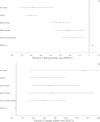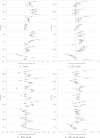Inflammatory and oxidative stress responses of healthy young adults to changes in air quality during the Beijing Olympics
- PMID: 22936356
- PMCID: PMC3530204
- DOI: 10.1164/rccm.201205-0850OC
Inflammatory and oxidative stress responses of healthy young adults to changes in air quality during the Beijing Olympics
Abstract
Rationale: Unprecedented pollution control actions during the Beijing Olympics provided a quasi-experimental opportunity to examine biologic responses to drastic changes in air pollution levels.
Objectives: To determine whether changes in levels of biomarkers reflecting pulmonary inflammation and pulmonary and systemic oxidative stress were associated with changes in air pollution levels in healthy young adults.
Methods: We measured fractional exhaled nitric oxide, a number of exhaled breath condensate markers (H(+), nitrite, nitrate, and 8-isoprostane), and urinary 8-hydroxy-2-deoxyguanosine in 125 participants twice in each of the pre- (high pollution), during- (low pollution), and post-Olympic (high pollution) periods. We measured concentrations of air pollutants near where the participants lived and worked. We used mixed-effects models to estimate changes in biomarker levels across the three periods and to examine whether changes in biomarker levels were associated with changes in pollutant concentrations, adjusting for meteorologic parameters.
Measurements and main results: From the pre- to the during-Olympic period, we observed significant and often large decreases (ranging from -4.5% to -72.5%) in levels of all the biomarkers. From the during-Olympic to the post-Olympic period, we observed significant and larger increases (48-360%) in levels of these same biomarkers. Moreover, increased pollutant concentrations were consistently associated with statistically significant increases in biomarker levels.
Conclusions: These findings support the important role of oxidative stress and that of pulmonary inflammation in mediating air pollution health effects. The findings demonstrate the utility of novel and noninvasive biomarkers in the general population consisting largely of healthy individuals.
Figures




Comment in
-
From Olympians to mere mortals: the indiscriminate, global challenges of air pollution.Am J Respir Crit Care Med. 2012 Dec 1;186(11):1076-7. doi: 10.1164/rccm.201209-1594ED. Am J Respir Crit Care Med. 2012. PMID: 23204374 Free PMC article. No abstract available.
References
-
- Brunekreef B, Holgate ST. Air pollution and health. Lancet 2002;360:1233–1242 - PubMed
-
- Brauer M, Hoek G, Smit HA, de Jongste JC, Gerritsen J, Postma DS, Kerkhof M, Brunekreef B. Air pollution and development of asthma, allergy and infections in a birth cohort. Eur Respir J 2007;29:879–888 - PubMed
-
- Brunekreef B, Beelen R, Hoek G, Schouten L, Bausch-Goldbohm S, Fischer P, Armstrong B, Hughes E, Jerrett M, van den Brandt P. Effects of long-term exposure to traffic-related air pollution on respiratory and cardiovascular mortality in the Netherlands: the NLCS-air study. Res Rep Health Eff Inst 2009;(139):5–71, discussion 73–89 - PubMed
Publication types
MeSH terms
Substances
Grants and funding
LinkOut - more resources
Full Text Sources

